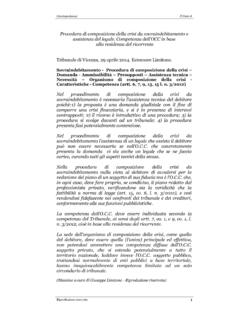Transcription of Crisi s I nt erven tion Tea m Core Elements
1 1 C r i s i s I n t e r v e n t i o n T e a m C o r e E l e m e n t s T h e U n i v e r s i t y o f M e m p h i s School of Urban Affairs and Public Policy Department of Criminology and Criminal Justice CIT Center1 S e p t e m b e r , 2 0 0 7 Randolph Dupont, PhD University of Memphis Major Sam Cochran, MS Memphis Police Services Sarah Pillsbury, MA University of Memphis2 Co n t r i b u t o r s O h i o F l o r i d a Mark Munetz, MD Michele Saunders, LCSW Summit County Alcohol, Drug Addiction Florida Partners in crisis and Mental Health Services Board Donald Turnbaugh Lt. Michael Woody (Ret.) NAMI Pinellas County Ohio Coordinating Center of Excellence in Criminal Justice K e n t u c k y Jim Dailey G e o r g i a NAMI Kentucky Nora Lott-Haynes, EdS NAMI Board of Directors NAMI Georgia Georgia Department of Education (ret.)
2 Virginia Inspector Janet Oliva, PhD Victoria Cochran, JD Georgia Bureau of Investigation Chairman, Virginia State MHMRSAS Board David Lushbaugh Isaac Van Patten, PhD NAMI Georgia Department of Criminal Justice, Radford University NAMI Board of Directors Amy Forsyth-Stephens, MSW Mental Health Association of the New River Valley 1 2006.
3 For use in assisting CIT programs. Obtain permission from first author for large-scale re-printing. Contact CIT Center at or (901) 678-5523. 2 Ms. Pillsbury is currently with the Department of Justice Federal Bureau of Investigation (FBI). 2 Ta b l e o f C o n t e n t s Section PAGE 1. CIT Model core Elements : Summary 3 2. CIT Model core Elements : Outline 4 3. CIT Model core Elements : Detailed 5 Ongoing Elements 5 Partnerships: Law Enforcement, Advocacy, Mental Health 5 Community Ownership: Planning, Implementation & Networking 9 Policies and Procedures 10 Operational Elements 12 CIT: Officer, Dispatcher, Coordinator 12 Curriculum: CIT Training 14 Mental Health Receiving Facility: Emergency Services 16 Sustaining Elements 17 Evaluation and Research 17 In-Service Training 18 Recognition and Honors 19 Outreach: Developing CIT in Other Communities 20 3 S E C T I O N 1 CI T Mo d e l Co r e E l e m e n t s.
4 Su m m a r y The crisis Intervention Team (CIT) is an innovative first-responder model of police-based crisis intervention with community, health care, and advocacy partnerships. The CIT Model was first developed in Memphis and has spread throughout the country. It is known as the Memphis Model. CIT provides law enforcement-based crisis intervention training for assisting those individuals with a mental illness, and improves the safety of patrol officers, consumers, family members, and citizens within the community. CIT is a program that provides the foundation necessary to promote community and statewide solutions to assist individuals with a mental illness. The CIT Model reduces both stigma and the need for further involvement with the criminal justice system.
5 CIT provides a forum for effective problem solving regarding the interaction between the criminal justice and mental health care system and creates the context for sustainable change. Basic Goals: Improve Officer and Consumer Safety Redirect Individuals with Mental Illness from the Judicial System to the Health Care System In order for a CIT program to be successful, several critical core Elements should be present. These Elements are central to the success of the program s goals. The following outlines these core Elements and details the necessary components underlying each element. CO R E E L E M E N T S Ongoing Elements 1. Partnerships: Law Enforcement, Advocacy, Mental Health 2. Community Ownership: Planning, Implementation & Networking 3. Policies and Procedures Operational Elements 4.
6 CIT: Officer, Dispatcher, Coordinator 5. Curriculum: CIT Training 6. Mental Health Receiving Facility: Emergency Services Sustaining Elements 7. Evaluation and Research 8. In-Service Training 9. Recognition and Honors 10. Outreach: Developing CIT in Other Communities 4 S E C T I O N 2 CI T Mo d e l Co r e El e m e n t s : Ou t l i n e Ongoing Elements 1. Partnerships: Law Enforcement, Advocacy, Mental Health A. Law Enforcement Community B. Advocacy Community C. Mental Health Community 2. Community Ownership: Planning, Implementation & Networking A. Planning Groups B. Implementation C. Networking 3. Policies and Procedures A. CIT Training B. Law Enforcement Policies and Procedures C. Mental Health Emergency Policies and Procedures Operational Elements 4. CIT: Officer, Dispatcher, Coordinator A.
7 CIT Officer B. Dispatch C. CIT Law Enforcement Coordinator D. Mental Health Coordinator E. Advocacy Coordinator F. Program Coordinator (Multi-jurisdictional) 5. Curriculum: CIT Training A. Patrol Officer: 40-Hour Comprehensive Training B. Dispatch Training 6. Mental Health Receiving Facility: Emergency Services A. Specialized Mental Health Emergency Care Sustaining Elements 7. Evaluation and Research A. Program Evaluation Issues B. Development Research Issues 8. In-Service Training A. Extended and Advanced Training 9. Recognition and Honors A. Examples 10. Outreach: Developing CIT in Other Communities A. Outreach Efforts 5 S E C T I O N 3 CI T Mo d e l Co r e El e m e n t s : De t a i l e d 3 . 1 O n g o i n g E l e m e n t s 1 . P a r t n e r s h i ps: L a w E n f o r c e m e n t, A d v o c a c y, M e n ta l H e a l t h A.
8 Law Enforcement Community Participation and Leadership within the Law Enforcement Community Central to the formation and success of CIT is the role of the law enforcement community. Trained CIT Officers are able to interact with crisis situations using de-escalation techniques that improve the safety of the officer, consumer, and family members. In addition, the law enforcement community is able to provide care and help to consumers by transporting individuals in need of special treatment to appropriate facilities. It is also critical that all law enforcement participate in the formation of CIT and engage in all Elements of the planning and implementation stages. Often those involved in the formation of the CIT program will become or help select the CIT coordinator for a particular law enforcement agency.
9 The two main components within the law enforcement partnership are the operational crisis Intervention Team within a law enforcement agency and general criminal justice system participants. 1) Law Enforcement: CIT Operational Component Police Department Sheriff s Department 2) Law Enforcement: Criminal Justice Partnership Component Corrections Judiciary Public defender, State Attorney, Judges, Probation/Parole Crime Commission/Public Safety Commission 3) Law Enforcement: Policy Development Component Law enforcement command staff Training and Standards 6 1. P a r t n e r s h i p s : L a w E n f o r c e m e n t , A d v o c a c y , M e n t a l H e a l t h B. Advocacy Community Participation and Leadership within the Advocacy Community Participation from the Advocacy Community is critical to the success of CIT.
10 This partnership provides strong support from passionate and dedicated people whose goal is to improve the quality of life for individuals affected by a mental illness. Leadership roles should develop in the form of liaisons that help voice the support, ideas, and concerns of consumers and family members. This aspect of CIT brings the program to life by adding insight from those directly affected. This important partnership should be established early in the planning process and should continue as an ongoing operational element of CIT. 1) Consumers/Individuals with a Mental Illness The personal accounts of individuals with a mental illness greatly enhance the planning process, officer training, and on-going support for CIT. Officers are able to gain an improved understanding and more realistic view of mental illness through these first-hand presentations.






